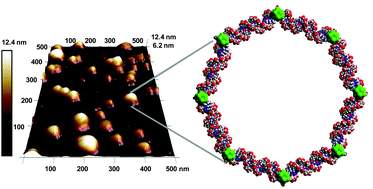Boron clusters as a platform for new materials: composites of nucleic acids and oligofunctionalized carboranes (C2B10H12) and their assembly into functional nanoparticles†
Abstract
Nucleic acids are key biomolecules in all life forms. These biomolecules can encode and transfer information via Watson-Crick base-pairing interactions and can form double-stranded structures between complementary sequences with high precision. These properties make nucleic acids extremely successful in applications in materials science as nanoconstruction materials. Herein, we describe a method for the automated synthesis of “oligopeds”, which are building blocks based on the boron cluster structure equipped with short DNA adapters; these building blocks assemble into functional nanoparticles. The obtained, well defined, torus-like structures are the first DNA nanoconstructs based on a boron cluster scaffold. The results indicate the potential of boron clusters in DNA nanoconstruction and open the way for the design of entirely new types of buildings blocks based on polyhedral heteroborane geometry and its unique properties. The use of antisense oligonucleotides as DNA adapters illustrates one of the possible applications of the obtained nanoconstructs as vectors for therapeutic nucleic acids.



 Please wait while we load your content...
Please wait while we load your content...